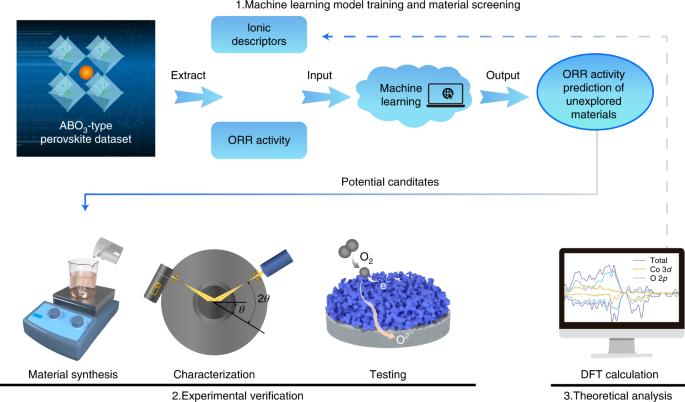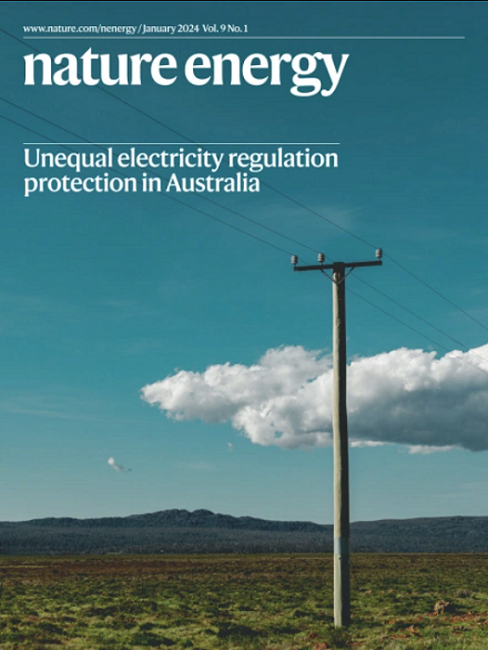结合离子路易斯酸描述符和机器学习方法预测陶瓷燃料电池的高效氧还原电极
IF 49.7
1区 材料科学
Q1 ENERGY & FUELS
引用次数: 36
摘要
为促进陶瓷燃料电池技术的商业化,需要改进的高活性阴极材料。然而,材料设计、表征和测试的传统试错过程可能会造成漫长而复杂的研究周期。在这里,我们展示了一种经过实验验证的机器学习驱动方法,以加速发现高效的氧还原电极,其中引入了离子路易斯酸强度(ISA)作为包晶氧化物氧还原反应活性的有效物理描述因子。从 6871 种不同的包晶组成中筛选出的四种氧化物被成功合成,并被证实具有优异的活性指标。实验表征显示,减少包晶氧化物中的 A 位 ISAs 和增加 B 位 ISAs 可大大改善表面交换动力学。理论计算表明,这种活性的提高主要归因于 A 位和 B 位 ISAs 的极化分布引起的电子对转移,从而大大降低了氧空位的形成能量和迁移障碍。材料设计、表征和测试的研究周期缓慢,阻碍了用于固体氧化物燃料电池的新型阴极材料的开发。在此,作者开发了一种机器学习方法,利用离子路易斯酸强度作为描述因子,用于发现改进的过氧化物阴极。本文章由计算机程序翻译,如有差异,请以英文原文为准。

A combined ionic Lewis acid descriptor and machine-learning approach to prediction of efficient oxygen reduction electrodes for ceramic fuel cells
Improved, highly active cathode materials are needed to promote the commercialization of ceramic fuel cell technology. However, the conventional trial-and-error process of material design, characterization and testing can make for a long and complex research cycle. Here we demonstrate an experimentally validated machine-learning-driven approach to accelerate the discovery of efficient oxygen reduction electrodes, where the ionic Lewis acid strength (ISA) is introduced as an effective physical descriptor for the oxygen reduction reaction activity of perovskite oxides. Four oxides, screened from 6,871 distinct perovskite compositions, are successfully synthesized and confirmed to have superior activity metrics. Experimental characterization reveals that decreased A-site and increased B-site ISAs in perovskite oxides considerably improve the surface exchange kinetics. Theoretical calculations indicate such improved activity is mainly attributed to the shift of electron pairs caused by polarization distribution of ISAs at sites A and B, which greatly reduces oxygen vacancy formation energy and migration barrier. The slow research cycle of material design, characterization and testing has hampered the development of new cathode materials for solid oxide fuel cells. Here the authors develop a machine-learning approach, which makes use of ionic Lewis acid strength as a descriptor, for discovery of improved perovskite oxide cathodes.
求助全文
通过发布文献求助,成功后即可免费获取论文全文。
去求助
来源期刊

Nature Energy
Energy-Energy Engineering and Power Technology
CiteScore
75.10
自引率
1.10%
发文量
193
期刊介绍:
Nature Energy is a monthly, online-only journal committed to showcasing the most impactful research on energy, covering everything from its generation and distribution to the societal implications of energy technologies and policies.
With a focus on exploring all facets of the ongoing energy discourse, Nature Energy delves into topics such as energy generation, storage, distribution, management, and the societal impacts of energy technologies and policies. Emphasizing studies that push the boundaries of knowledge and contribute to the development of next-generation solutions, the journal serves as a platform for the exchange of ideas among stakeholders at the forefront of the energy sector.
Maintaining the hallmark standards of the Nature brand, Nature Energy boasts a dedicated team of professional editors, a rigorous peer-review process, meticulous copy-editing and production, rapid publication times, and editorial independence.
In addition to original research articles, Nature Energy also publishes a range of content types, including Comments, Perspectives, Reviews, News & Views, Features, and Correspondence, covering a diverse array of disciplines relevant to the field of energy.
 求助内容:
求助内容: 应助结果提醒方式:
应助结果提醒方式:


